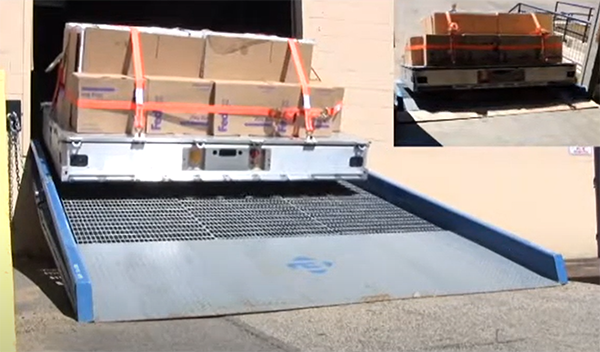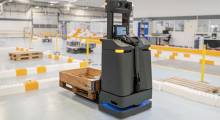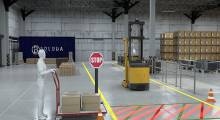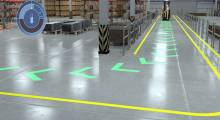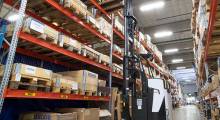Loading and unloading cargo from aircraft can be difficult and potentially dangerous, particularly in military situations in varied terrain. Stratom Inc. last week said that the U.S. Marine Corps has awarded it a Small Business Innovation Research Phase 2 contract to develop a prototype Autonomous Pallet Loader vehicle.
“Current cargo operations are time-consuming, strenuous, expensive, and occasionally dangerous for military personnel,” stated Mark Gordon, president and CEO of Stratom. “This is a strategic win that helps grow our portfolio of autonomous unmanned heavy cargo movement systems and illustrates the viability of leveraging such solutions for not only the defense industry, but commercial sector applications as well.”
Founded in 2001, Stratom specializes in robotics, unmanned vehicles, systems engineering and integration, and payload development. The Boulder, Colo.-based company has developed systems for refueling, hazardous liquid transfer, and cargo movement.
APL builds on previous USMC work
Stratom said its Autonomous Pallet Loader (APL) will move cargo in and out of CH-53K and C-130 helicopters and across landing zones. The system is intended to reduce the time and cost of loading and unloading cargo and automate the pacement and retrieval of pallets on dunnage.
“It's like moving around an industrial yard with heavy lift capacity,” Gordon told Robotics 24/7. “But there are mobility issues—rough terrain is different from most commercial spaces. The APL will bring supplies or equipment to outdoor servicing environments.”
The APL prototype builds on Stratom's previous work with the U.S. Marine Corps (USMC) and the U.S. Army on the eXpeditionary Robotic-Platform (XR-P) and eXepditionary Robotic-Field Artillery Autonomous Resupply (XR-FAAR) vehicles.
“The XR-P was the first program to show the potential of autonomous loading in and out of aircraft,” said Gordon. “The APL will have similar capabilities in a larger form factor. Stratom has done a lot of project work on the heavier side of cargo movement.”
“The system is designed to maneuver 463L pallets used across all [U.S. armed] services,” he explained. “It will be able to pick up pallets roughly 7 ft. by 9 ft., weighing 10,000 lb.”
The APL will move at a “brisk walking pace, close to that of a standard forklift,” and run on a diesel-electric hybrid motor, Gordon said. “That will provide more longevity and duration of operations.”
Designing for dynamic environments
Stratom is currently developing the autonomous vehicle software and hardware in accordance with USMC requirements.
“The APL will have its own internal autonomy, based on the Mobile Autonomous Vehicle software and ROS 2,” said Gordon, referring to the latest version of the Robot Operating System. “We're integrating pieces that are appropriate for our application and blending it with mobility for rough terrain. The vehicle can roll over it, and we can finesse overcoming obstacles with software.”
“The military uses ROS-M, which uses the same types of principles as commercial ROS,” he noted. “We're focusing on what needs to be done and providing best-in-class capabilities for safety and reliability. We're building on the software architecture and will have emergency stops, both on the vehicle and the operator control unit. The sensors will understand the environment.”
On the hardware side, how much will the APL rely on custom parts? “We try to use as much off-the-shelf items as we can to drive down the cost—computing power, lidar, and electronics,” replied Gordon. “But because we have a specific payload and form factor centered around the vehicle and its propulsion system, we'll do a structural analysis of the mechanical components.”
Stratom will be using a combination of simulation and field testing for the APL. “We'll use both on the mechanical side, with finite element analysis for subassembiles to dynamic simulation at the vehicle level,” Gordon said. “Also, for all autonomy products, we build in simulation first and then test vehicle characteristics.”
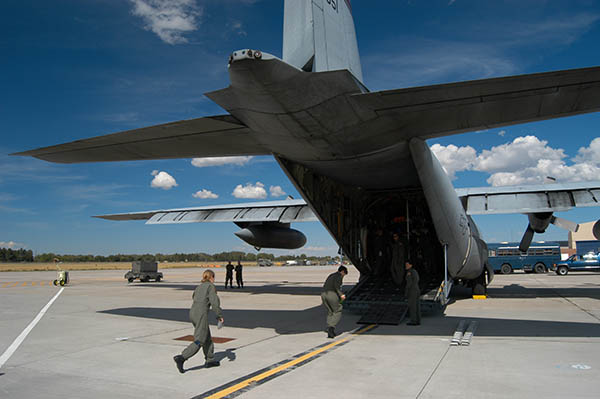
Controls and coordination
Stratom is considering multiple modes of control for the APL. “We are looking at different operating modes, such as teleoperation and autonomous operations, depending on the user's needs at the time,” Gordon said. “We're also looking at combinations of wireless and tethered mode, which is more secure.”
How much training will be required? “We want a warfighter to be able to pick up an OCU [optical control unit] and use its graphical user interface and be up and running within five to 15 minutes,” he added. “The goal is to be user-friendly. A lot of these applications take marines and soldiers out of harm's way by having the autonomous sytems do this logistics work while they stay back in covered positions.”
In addition, the autonomous mobile robots will also work with other systems.
“We do foresee operating with other APLs and communicating with higher infrastructure for mission planning and inventory control systems,” said Gordon. “With autonomous aircraft, there are two ways our system could be used. We could drive off and go to a location, or we could mirror up to an aircraft, where there's another APL, and move crossdeck.”
“And it's not just from an aircraft—the APL could move pallets from a truck or from one warehouse location to another,” he said.
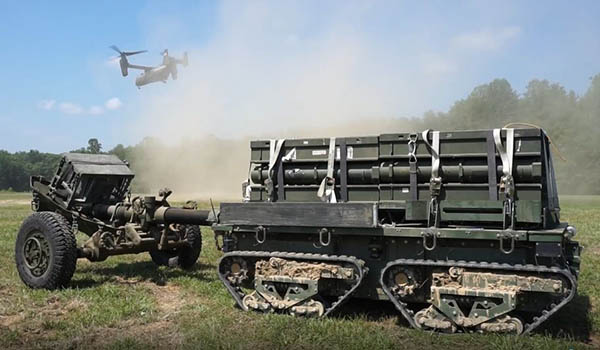
SBIR and other applications
The Small Business Innovation Research (SBIR) program is designed to encourage small businesses to engage in federal research and development with the potential for commercialization.
“We're in the design phase within the SBIR contract, and we'll be building the system after that,” Gordon said. “Then will come internal testing and working with customers on demonstrations. There's a lot of focus within the DoD [U.S. Department of Defense] on using robotics, and companies can then move into commercial applications.”
“There are lots of potential use cases in mining and construction,” acknowledged Gordon, who was previously chair of the Association for Unmanned Vehicle Systems (AUVSI). “Right now, we're really focused on practical problem-solving and understanding the customer's mission.”
About the Author
Follow Robotics 24/7 on Linkedin
Article topics
Email Sign Up

